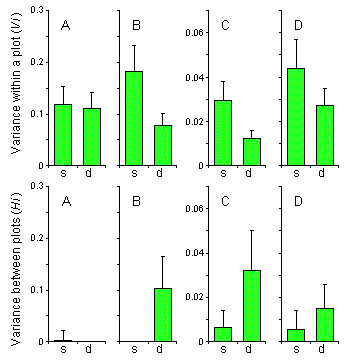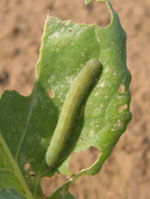Debate on the relationship between biodiversity and stability goes back to
the
1950's. Elton (1958) presented several "evidence" about the diversity-stability
relationship, such that (1) insect population outbreaks frequently occur in arctic
regions but rarely occur in tropical regions where number of species is large,
and (2) insect population outbreaks most often happen on cultivated or planted
land, that is, in habitats and communities very much simplified by humans. However,
the biodiversity-stability hypothesis has been shown to be false by the mathematical
results of May (1972) who found that greater diversity led to lower local stability
of multispecies equilibrium in a Lotka-Voltera competitive model. Thus, there
is currently no theoretical foundation about the positive relationship between
biodiversity and stability. We recently found that biodiversity may "indirectly" enhance
the stability of population dynamics. In an environment with many species
such as a tropical community, the food plants of herbivores are rather sparsely
distributed. Such sparseness seems to be an inevitable consequence of biodiversity
(species richness) of plant species. Then, we constructed the following hypothesis:
(1) Sparseness of food plants of herbivores increases with increasing number of
plant species, (2) spatial sparseness of food plants reduces the dispersal rate
of herbivores between food plants, (3) such a decrease in dispersal rate causes
a larger spatial variance in the consumption rate of food plants, (4) such a large
spatial variance in the consumption rate of food plants reduces the temporal variance
in the amount of food plants, and (5) the reduced temporal variance in the amount
of food plants yields a smaller variance in the temporal dynamics of herbivores.Let x be the amount of feeding pressure on a plant. Let f(x)
be a smooth decreasing function describing the amount of food plants escaped
from
feeding under a feeding pressure of x. Let V1(x)
the spatial variance of x in a field in which food plants are sparsely
planted, V2(x) be that in densely planted field. Then,
we have the following relation under the second and third component of the hypothesis
![]()
Let H1 and H2 be the resultant variances
of mean amount of f(x). Then, we can derive the following inequality:
![]()
Thus, the variance is kept smaller in sparsely planted fields, indicating that
the herbivorous population is kept stable in diversified communities.
The theoretical prediction was confirmed by field experiments. We planted cabbage
seedlings at two levels of sparseness: in sparsely planted plots, 1 m apart;
and in densely planted plots, 0.2 m apart. We measured the dry weight of leaves
that escaped from larval feeding by the small white butterfly (Pieris rapae
crucivora). The spatial variance in the amount of leaf dry weight was smaller
in densely planted plots, while the temporal variance was smaller in sparsely
planted plots. Thus, the field results also indicated that the sparseness of
food plants in diversified communities may generate the stability of herbivorous
populations.
 |
||
 |
||
 |
||
Larva of Pieris rapae crucivora |
Adult of Pieris rapae crucivora |
Figure 1. Influence of spatial sparseness of food plants on the stability of herbivorous population dynamics. The square root of dry weight (g) of cabbage leaves escaped from larval feeding is compared. Each bar shows maximum likelihood estimate } asymptotic SE. s: sparsely planted plots (1~1 m in plant spacing). d: densely planted plots (0.2~0.2 m in plant spacing). A. block 1 in 1994, B. block 2 in 1994, C. block 1 in 1996, D. block 2 in 1996. (Copyright by the Society of Population Ecology and Springer-Verlag Tokyo).